-
收藏模板
- 模板信息
- 更新时间:2023-09-09
- 字数:约42056字
- 页数:约36页
- 格式:.doc
- 推荐版本:Office2016及以上版本
- 售价:5 金币
您可能喜欢的文档
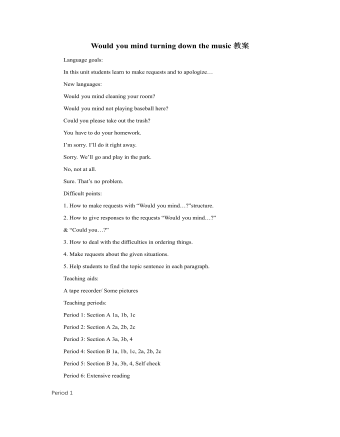
人教版新目标初中英语八年级下册Would you mind turning down the music教案
Step 4. Group work (4)1. Ask a pair of students to read the dialogue. Say, This activity provides speaking, listening and writing practice using the target language.2. Ask students to complete the work in groups.3. Check the answers with the whole class. 4. Explain some of the language points. Step 5. Word review (Self check 1)1. Ask students to read the words and the phrases given. 2. Fill in the blanks with proper forms of these words to complete the sentences. 3. Check the answers with the whole class. Homework:Do activity 2 on page 57 after class. Period 6Teaching aims: 1. Teach vocabulary words and the useful expressions. 2. Enable the students to learn etiquette in different culture. 3. Help the students learn how to behave politely in public places and in daily life. Teaching procedures:Step 1. RevisionHelp students to review the function of making requests through a free talk. Then lead them to the topic of etiquette. Explain the meaning of etiquette. Or, ask students to look it up in the dictionary. Step 2. Pre-reading (Section 1)1. Ask students to read the picture and make a list with their partner about how many rules of etiquette can be seen being broken.
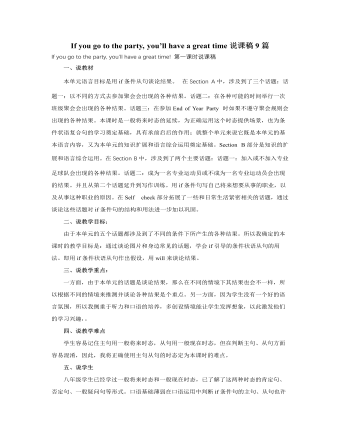
人教版新目标初中英语八年级下册If you go to the party, you’ll have a great time说课稿9篇
二、说教学目标:由于本单元的五个话题都涉及到了不同的条件下所产生的各种结果。所以我确定的本课时的教学目标是:通过谈论图片和身边常见的话题,学会if引导的条件状语从句的用法。即用if条件状语从句作出假设,用will来谈论结果。三、说教学重点:一方面,由于本单元的话题是谈论结果,那么在不同的情境下其结果也会不一样,所以根据不同的情境来推测并谈论各种结果是个重点。另一方面,因为学生没有一个好的语言氛围,所以我侧重于听力和口语的培养,多创设情境能让学生发挥想象,以此激发他们的学习兴趣,。四、说教学难点学生容易记住主句用一般将来时态,从句用一般现在时态,但在判断主句、从句方面容易混淆,因此,我将正确使用主句从句的时态定为本课时的难点。
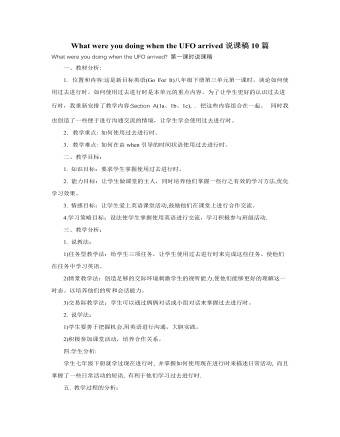
人教版新目标初中英语八年级下册What were you doing when the UFO arrived说课稿10篇
知识目标:a. 掌握新单词:shout; jump down; climb; scaredb. 掌握并会运用句型:—What were you doing at 8o’clock last night?—I was doing my homework.技能目标:a. 能听懂听力材料的内容,并能做出相应的练习。b. 提高学生听和说的能力。二.教法与学法本节课采取了任务型教学法,通过让学生完成不同的任务来完成不同的教学活动。本节课采用了Brainstorming、Pairwork、Groupwork等活动,实现了让学生说的目标。通过补充故事让学生巩固新学的单词,通过小组的活动让学生参与到问题的讨论中,让学生开口说。三.学情分析通过几个学期的学习,学生已经积累了一定的词汇,并熟练掌握了一些句型。本节课的热身部分是给了学生一个问题:What were you doing at 8 o’clock last night? 通过学生本身的活动来引起他们的兴趣,并对前面的内容进行了复习。四.教学重难点a.掌握本节课所学新单词:shout; jump down; climb; scaredb.掌握和巩固本单元的句型和语法(过去进行时)
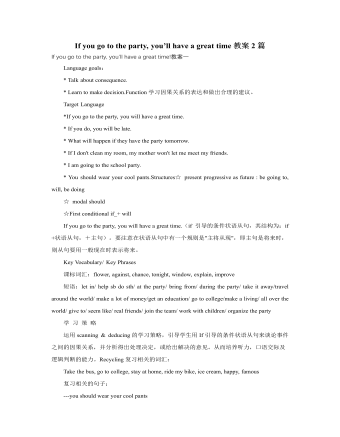
人教版新目标初中英语八年级下册If you go to the party, you’ll have a great time教案2篇
区分宾语从句、定于从句和状语从句宾语从句和状语从句,都叫做主从复合句。宾语从句主要是中考必考的,是初中阶段必掌握的从句,宾语从句主要是掌握三要素,所谓宾语从句,就是宾语在主从复合句当中充当宾语的一个句子,叫做宾语从句。主句的谓语动词是及物动词,后面如果是词或者是短语的话,是简单句,如果是句子的话,肯定是宾语从句。I know that he good at English.就是宾语从句,三要素,一要素是要注意连词,连词一共学了三类连词,一类连词是that口语当中可以省略,就像刚才说的那一句,I hear he is good at English.还有疑问代词、疑问副词,how where when,疑问代词、疑问副词。还有一类连词weather是否的意思,不是状语从句当中的如果,这一定要和如果区分开,这是是否。I don't know if he interested at English。宾语从句要注意if是连词。第二要素是语序,要用陈述举语序。比如说你家有几口人,我们都说How many people are there in you family?但是这是简单句,一旦说成宾语从句,你可以告诉我你家有几口人吗?Could you tell me how many people there are in you family ?
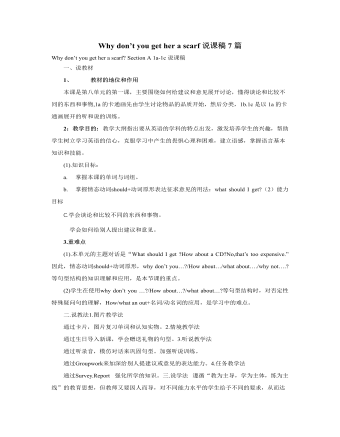
人教版新目标初中英语八年级下册Why don’t you get her a scarf说课稿7篇
[设计意图: 该环节可让学生展示自我,拓宽运用英语能力,把所学的知识在实际交流中进行运用,实现新课程倡导的“为用而学, 在用中学,学了就用”,从而提高学生综合运用英语的能力。选择母亲节来临为母亲选择礼物这一话题也是借此机会对学生进行感恩教育,并在学生的热烈讨论中告诉学生gift can’t be everything, everything can be a gift.使学生的情感得到升华。] Step9 Summary T: What have we learned in this class? Presents/ Gifts Comments Suggestions Album----special Why don’t you … Bicycle----useful Why not … +V原形 Calendar----interesting How about … Scarf----personal What about … +V-ing/ 名词 [设计意图:此环节的设计,有助于理清脉络,进一步巩固所学知识。] Step10 Homework 1. listen to 1b (do 1b and imitate ) 2. Write down your dialogue 3. Surf the internet about the differences of gift giving between China and foreign countries. [设计意图:作业1听力,由于1b听力和后面的2a相似,所以课堂上不再重复做,将其留做课后作业,上课下课时刻关注学生听力能力的培养和训练。2是将学生课堂上的说落实到课后的写。3是让学生通过自主学习,了解中西方文化的差异。分层次布置作业,体现出因材施教的教学理念。]
- 查看更多相关Word文档
Would you mind turning down the music说课稿8篇
Would you mind turning downthe music? 第一课时说课稿
一.教材分析:
1、教材的地位及作用:
新目标英语八年级下册,第七单元第一课时,本单元主要是运用Would you mind doing…?这个句型来提出客气的请求,并能作出相应的回答,本节课主要复习一些短语,及两个表礼貌请求的句型并学习Would you mind…?的用法,并能运用它们进行对话练习,提出委婉的请求。

2、教学目标:(知识目标、能力目标、情感目标)
知识目标:
(1)学习词汇:mind ,yard,dish,turn down,right away,in a minute,not at all
(2)掌握句子:Would you mind doing…?Could you please do sth ?Would you liketo do sth ?No,not at all./Certainly not./Of course not.能力目标:提高学生听、说、读、写及知识自学的综合能力。
情感目标:通过形象、生动的教学使学生掌握如何向他人提出有礼貌的请求,培养学生在日常生活中礼貌待人。
学习策略目标:自主学习及小组合作探究,善于抓住语言交际的机会。
确立教学目标的依据:
根据英语课程标准规定,通过听、说、读、写的训练,使学生获得英语基础知识和为交际初步运用英语的能力,激发学生的学习兴趣,为进一步学习打好初步的基础。综合素质教育得到提高。
3、重点与难点:
重点:学会句型Would you mind doing…?
难点:提出客气的请求并作出相应回答。
确立重点与难点的依据:根据课程标准的要求,及本课在教材中所处的地位和作用。
二、说教法及学法:
本节课我主要采用先学后教,小组合作探究学习的教学法。如在自学提示中设置一些问题,使学生在回答问题中总结语法点。自学后在小组内交流,相互帮助学习、理解。而老师起到了引导的作用,把课堂的主体交给学生。
三、说流程:
1.总体设计及依据
课前热身-自学提示—短语积累-对话练习-活学活用—能力提升—作业布置
制定依据:
⑴遵循人类认识过程的普遍规律和学生认识活动的特点。
⑵教师为主导,学生为主体。
2.分步设计及依据
Step1课前热身
通过完成四道小题,回顾并总结两种表客气的提出请求的句型Could you please(not)do sth ?Would you like(not) to do sth ?同时引出本节即将学习的另外一种表达法Would you mind…? 为新课活动做准备。
Step 2自学提示
通过在语法讲解中设立问题,让学生自学完成任务,并在通过自学后,学生自主总结出“Would you mind+doing/one’s doing/if从句?”的用法。变被动死记硬背为主动归纳,加深对语法的理解能力,有利于学生记忆语法深刻、牢固。
Step3短语积累
用图片学习及复习本节重点短语。直观教学,加深印象,并为下一环节对话练习做好准备。
Step4对话练习
根据所学句型及短语进行对话练习,让学生学会交际使用,训练说的能力。
Step5活学活用
设立习题,对所学知识进行当堂训练,考察学生对知识的掌握程度,加深语法理解,培养做题的速度及准确度。
Step6能力提升
安排学生运用本节句型,写一个简短便条,委婉地请求朋友帮忙,培养学生写作能力。
Step7小结及作业布置
给学生1分钟,让他们总结出本节的收获,并教育学生在日常生活中要做一个有礼貌的人。给学生布置课外作业,巩固所学知识。
Would you mind turning down the music?Section A说课稿
1 教学内容:
Go for it 八年级英语下册单元Section A 部分。其核心内容是“如何请求及表示歉意”。本部分始终围绕着这一主题安排了听、说、读、写的活动任务,让学生在这些环节中学会用更加礼貌的请求方式“Would you mind doing things ?”“Would you mind not doing things?” 以及表示歉意的回答—Sorry ,Not at all / I’ll do it right away 等。同时,本人将分两个课时完成。
3 教学目标:
根据“新课程标准”关于教学目标的要求,结合本单元的具体内容,在SECTION A部分,目标细分如下:
1. 语言知识
A、词汇---SECTION A部分新单词较少,主要掌握如下:
dish,yard,wearjeans,puton,getoutof,inaminute.
B、语法---Would you mind doing sth
Would you mind not doing sth
复习could you please /could you /would you / have to 的用法
C、功能---学会礼貌性的请求和表示歉意
2. 学习策略
首先,是自主学习法。在本堂课中主要体现在学生看图片讨论、做听力、通过对话操练句型等环节中。
其次,是合作学习法,主要体现在自编对话,表演对话等环节中。
再次,是情景体验法。情景教学是本堂课自始至终的主线,如何请求别人做某事,就是让学生在相应的情景中体验出来的。
3. 情感目标
A、学会拒绝或阻止他人的不礼貌行为,增强学生适应社会的能力。
B、学会用平和的心态礼貌地处理好生活中遇到的或突发的难题。
5. 能力目标: 指导学生在自主探究和任务型教学模式中,让学生学会用礼貌性的英语请求及如何表示歉意. 学会更好的与他人沟通。这亦是素质教育的“以人为本”的目标体现。
三.单元重难点
委婉地提出请求、表示歉意。
Would you mind moving the bike ? No, not at all
Would you mind not playing baseballhere ? Sorry , I’ll go and play in the park .
2.难点。
在实际的生活中委婉地表达自己的请求和歉意(即学生说的能力培养),学会沟通。
四、学情分析及教学策略
本课话题来自学生的生活经历,在八年级上册UNIT 11学生已经学习了许多动词短语,为表达提供了语言基础。此外,学生已掌握了用祈使句和Can you…?/could you 及Could you please提出请求, 为本课的学习打下了铺垫。具有了学习本单元知识的认知前提,能自然的与本单元的话题衔接。但是,在语法上也就容易形成混淆。同时,本单元是关于礼貌性的话题,内容贴近生活,学生比较容易进入角色。因而,教师在课堂中应通过大量的生活场景图片来促使学生积极地参与,在任务型教学活动中,使学生有话想说,有话可说,在完成各项任务的过程中自主学习语言,提高他们综合运用语言的能力,学会更好地与他人沟通。使各层次的学生都有所收获。
五、教学过程设计
Period1
1. Target language :
: Mind yard dish
Cleaning the yard /playing baseball/turning down the music /getting up /doing the dishes /wearing jeans /gettingout of the bathroom.
Key sentence: Would you mind moving your bike?
I’ll do it right away.
Would you mind not playing baseballhere?
Sorry. We’ll go and play in the park.
Ability goals:How to make request and Apologize
Learning Ability : Enable Ss to make request andapologize
Important and difficult points :make request using would you mind+ving structure .
1. Greeting and Warm-up:
T:Boys and girls , are you happy today ?
I’mvery happy ,too. Because I helped my mother do chores this morning . Whatchores do you often do at home ?
S: We do the dishes / do the laundry / washthe clothes / make the bed and so on . (热身部分以简单的对话使学生说出各种家务活短语,为下一环节would you mind +ving 句型的操练做语言铺垫)
2. Lead –in (With a picture )
(导入部分:首先,出示一张客厅的图片,一一提问学生以下几个问题,Where is it ? What do you think of it ?What should we do ? 引导学生回答:It’s Bob’s living room. It’s very dirty .We should clean theroom. 之后,让学生猜妈妈对B所说的话,猜的目的是使学生对以往所学的表示请求方式的一个回顾,更自然地引入本堂课的重点—礼貌性的请求他人做某事及歉意的表达。在图片展示时,告诉学生,would you mind +ving 是本节要学习的内容,提示would you mind 后面的动词要加ing。
3. sweeping the floorfolding the clothesmaking the beddoing the laundrydoing the dishesbabysitting the sister .(之后,通过学生熟悉的短语操练Would you mind +ving 结构)
4. T ask: now , lets look at some pictures , can you find whatsmatter? Ss : the music is too loud . She use the telephone too long .and so on(在学生对重点结构有一定的认知基础上,让学生对书本1A部分进行自由讨论。寻找问题,用目标语would you mind 请求解决。自由讨论是为完成1A的配图及1B的听力减轻难度。)
5. Match and listen(1a-1b) . Then ask Ss to match and listen to1a.
4. Pair-work (在分角色读完四组对话后,学生两人一组编对话表演,在模仿的基础上,学生进一步的练习生活中如何请求他人做某事及表示歉意)。
5. Listen number and match (2a—2b)
1) show 5 pictures from 2A together, and ask Ss to make requestusing would you mind ? Then check their answers.
2) listen and number the pictures.Next, listen again and match request with apologize.(在2A听力之前,先让学生对2A的5张图片讨论,说出恰当的请求方式,为该环节的听力做铺垫。
6. Pair—work 以组对组或男对女的形式操练2A部分的对话。
7. Task 1---
Your neighbor made lots of noises lastnight . Today , you want to tell him not to do again , so if you are Xiao ming, how to make request ? and how to say sorry as neighbor . Four Ss as a groupwill act out your dialogue. Let’s see who is our best neighbor . (评价)(为了巩固学生对本堂课的重点(请求及表示歉意)的掌握,设计如下任务:小明隔壁搬来一家新邻居,但是,昨天晚上很吵,小明想上门提醒邻居。如果你是小明,你会怎么说?那么,你是新邻居,你又会如何反应呢?最后让学生评出谁是我们的好邻居。
Homework: 二(1)班要制定一份英文班规,请同学们用would you mind 开头列一份清单。
Period2
Teaching goals:
How to make request in real life ?
1. Lead-in: What do you often do on weekends ?
If your parents is not in , What can you dofor them ?
You help your parents do lots of things athome .
Now , let’s look some pictures from 3Aand see what Larry do at home for his mother 。Then ask S to read the requirement .Enable Ss to understand what they should do . After checking the answers on theblank ,explain the using difference amongwould you mind / could youplease / have to。。(在学生回答以上问题后,让学生先谈论3A的5张图片,说出图片相关的短语,这是为了在书写留言过程中,为学困生扫除短语障碍。同时,在完成留言后,老师让学生归纳would you mind / could you please /have to在语气上的区别及不同形式的动词搭配。最后请几个同学读本组的作品,老师和其他同学一起点评。利用各种形式:师生互问互答、分组对话、看图说话等反复操练句型,尽量让学生脱口而出.通过这活动学习并掌握feedthedog,cookdinner,gotothelibrary/returnthebooktothelibrary,
Doyourhomework Wash thedishes等短语.,充分调动了学生的积极性,吸引了全体学生的注意力
2. Pair-workTry your best to make dialogues as manyas possible using Would you , Could you , Have to
ORDER : Turn down the musicwash the dishesget upbabysit your little cousin (在3A的基础上,让学生分角色朗读对话,再用表格中的短语编对话表演。巩固对would you mind / could you please /have to的知识掌握)
3. Task2.4-groupwork 反复操练和巩固应用:为了调动学生的积极性,老师宣布明天是学校开放日,届时会有很多外校教师和家长到校参观和听课。集体讨论在学校开放日,需要做哪些工作,并将所需要做的工作的内容列表,为下一步作准备。然后以小组为单位落实或分配所列出的工作,最后在全班进行汇报,看那组工作细致。利用分组对话,以及回答问题、调查采访等不同方式操练巩固。使学生处于积极思维的状态之中,全方位、多角度地培养学生运用英语的能力。
掌握和操练如下动词词汇和句型:
make posters, clean the classroom,set up chairs in the classroom,
design the blackboard, welcome thepeople at the school gate,
hand out teaching plans or the booksto the people.
Would you mind…? Could you please…?Please /Please not … You have to…
Can you please…?
4. Homework :
Would you mind turning down the music?Section A说课稿二
一、说教材
(一)教材分析
本单元重点在于培养学生英语交际能力,并结合生活中切实常用的话题:给人们的日常行为提出一定的建议,做出礼貌的道歉行为来展开基本语言内容的教学,并与第八单元的内容具有一定的联系。本单元遵循教材总体特点,采用任务型教学模式,并融汇话题,交际功能和语言结构would you mind doingsth? 进而形成一套循序渐进的生活化的学习程序。学生比较容易乐于接受,说课的内容是本单元Section A(1a~1c)部分,本课是单元首篇,以 Would you mind turningdown the music? 为主题,本节内容具有词汇量较大,强调综合运用,贴近生活实际等特点。通过本节学习,可增加学生的单词储备量,提高学生综合运用能力,学生将学会用英文表达请求,表示歉意。在获取基础知识,发展基本能力的同时进一步强化学生学以致言,学以致用的英语学习观和合作品质。
(二) 教学目标
依据并结合新课程标准提出的基础教育阶段英语课程的总体目标和具体要求,我将本课教学目标设计如下:
知识目标:
让学生掌握其中的重要词汇mind, turn down, not at all等和句式would you mind doing sth? 并能让学生掌握如何运用所学句式提出礼貌请求以及礼貌的向他人道歉。
能力目标:
培养学生的听说读写能力,尤其是与他人用英语进行日常会话的能力。
情感态度目标:
在本课教学中注重培养学生的礼貌行为,了解英语国家中向他人提出要求及道歉的方式,并通过小组活动,培养学生乐于学习并与他人合作的精神。
(三)教学重难点
结合教学目标的要求,我把本课的重点设置为首先使学生掌握mind, not at all, turndown等重点词汇的用法,及课重点句型结构Would you mind doingsth? 并给出正确答语;怎样向别人有礼貌的道歉。
根据本课的内容和学生的实际,本课的难点为让学生掌握向别人提出请求的的句式Would you mind doing? 并给出正确的答语,能够在实际生活中应用。
二、说教法
1 学情分析
自己所任教班级学生英语基础比较薄弱,上课的课堂气氛不够活跃,中等学生占多数,但是学困生比例也比较多,两极分化比较严重,虽然经过六七年级的学习,学生能够进行简单的会话,但是在学习策略方面人存在许多要解决的问题。有些同学在学习中缺乏小组合作意识,并且不能够大胆的用英语交流。
2 教学方法
根据所任教班级的具体情况,在本堂课中以任务型教学作为课堂教学设计理念,具体采用情景交际教学法,交际教学法,在教学中突出实际性,注重听说的实用性,同时适时进行情感和策略调整,以形成积极的学习态度,促进语言实际运用能力的提高。坚持“师为主导,学生为主体,任务为基础”教学原则,在课堂教学的不同环节教师应扮演自身作为设计者,研究者,组织者,促进者和协调者的角色。贯彻教中学,学中用的策略,真正使学生学以致用。
三、说学法
根据学生实际情况和本节课的主要内容,在这一节课中学生主要通过同桌合作,小组合作以及自由对话来完成这节课的任务型教学。
四、说过程
Step1. Lead-in
通过情景设计进行free talk来导入本节课地主要内容。设计的情景时周末邀请一名学生去吃饭,老师使用的句型是Would you like to havedinner with me this Sunday?通过这个问题来调动学生的积极性,引导学生主动表达学生在生活中如何邀请其他同学去海边,去看电影等让学生通过思考这些表达方式来进行自由对话。
Would you like to dosth?
Can/could you please dosh?
How/what about doingsth?
Why don’t you do sth?
Why not do sth?
Let’s do sth.
Shall we do sth?
通过这个情景设计来引出本节课将要学习的用来礼貌的提出请求的句型:would you mind doingsth?
设计理念:通过情景设计来调动学生积极性并导入本节课的主要内容。
Step2 Pre-listeningtask
为学生展示课本上的图画,通过相关的问题来引导学生找出主要的动词短语:clean the yard, playbaseball, move the bike, turn down the music. 然后通过标题Would you mind turning down the music?带入词组进行反复训练,让学生充分熟练这个结构,同时在这一环节中通过图画中的烦乱画面对学生进行一定的情感教育:对于违反规则的一些事情要礼貌的提出请求。
设计理念:进行听力活动之前的热身,让学生尽可能熟悉本节课的重点内容,为后面进行的听力活动做好铺垫,便于学生融入听力活动。
Step3 Listening –task
在这一环节中设计了两个活动:
活动一:听一遍录音,完成activity1b,通过这遍听力注重would you mind doing?的问句。同时让学生注意前两个问题的不同,总结出这个句型的肯定和否定形式,然后有学生举例进行练习,并将学生的一些例子写在黑板上。
活动二:听第二遍录音,记录如何给出礼貌的回答,同时让学生对黑板上的例子进行回答练习。
设计理念:通过听力材料为媒介进行听说练习。
Step4 Pairork
同桌之间合作,利用本节课所学结构进行对话练习,要注意肯否定的同时训练。
设计理念:对所学句型的初步训练,进行对话练习,培养合作意识。
Step5 Groupwork
首先引导学生总结出日常生活的主要场所——学校的一些校规,四个同学分为一组,创设一个情景,可以是教室,操场,走廊,图书馆,实验室等学校的各个角落,根据所了解的学校规则来展开想象,常设一个情节比较完整的对话,尽可能多的运用之前学过的知识点,不仅仅局限于本节课所学句式,看看那个小组最有创意?哪个小组最好?
设计理念:小组合作,培养乐于学习与团队合作的意识,同时也是对礼貌提出请求和以前所学内容的复习。
Step6 Summary and test
引导学生总结本节课主要内容,然后进行当堂检测来检查本节课所学内容的掌握程度。
Step7 Homework
巩固性作业:完成伴你学句子乐园练习
拓展性作业:Write a letter to your best friend who you want to talk withabout his/her problems using the sentence structure.
五、课前预测
这节课的整体思路是导入——听前任务——听力练习——同桌合作——小组合作——总结——课堂反馈——作业布置,在这节课的设计上,导入和小组活动应该是本节课的亮点,但是在本节课进行之前应该注意的最大问题是设计的导入和小组活动要让学生动起来,才能达到教学设计的效果。由于任教班级学生日常上课气氛比较沉闷,因此在实际教学导入时,应充分利用板书来改变课堂现状,要避免自己在那单纯的提示学生造成课堂沉闷的状态。在教学的第二环节中让学生看图找出词组并运用词组进行训练,同时这一步应根据图画内容地凌乱来进行一定的情感教育,从而达到所设计的三维目标。通过本节课的学习,学生能够掌握日常生活中礼貌的提出请求和道歉所用到的主要语言结构,接受一定的情感教育,基本能够达到所设计的三维目标。
Would you mind turning down the music?Section A 英文说课稿
GoodMorning, ladies and gentlemen. It’s my pleasure to give my lesson presentation heretoday. The lesson plan I am going to present is Section A (1a-1c)
from Go for it, Unit7Would you mind turning down the music? Next, I’d like to explain how to teach and why to do so from the following 5aspects: the analysis of textbook, the analysis of teaching methods andlearning methods,the analysis oflearning condition, teaching procedure( blackboard work and myself-reflection).
Ⅰ.The analysis of the textbook
1.The statusand function of the textbook
The educational policy of “Gofor it ”is knowledgeused in action. It emphasizes learning by doing .”Gofor it ” uses theTask-Based Language Teaching pattern, blended together the topic, thecommunication function and the language structure has formed in an adaptationlearning program which proceeded in an orderly way, enhanced the student studythe English and actual ability.
2.The analysisof the text
This lesson`s topic is “Wouldyou mind doing sth?”. It talksabout how to ask sb to do sth in the politest way. From this lesson, studentscan know how to communicate with others in the politest way and use thesentences correctly. And also, students will be able to give their advice andsuggestions politely and gently.
3.Teaching goals(教学目标)
(1)Knowledge objects:
Key vocabularies: mind not at all, turn down, yard, right away
(2)Ability objects:
to train students` ability ofspeaking, listening , andcooperative ability.
4.Teaching key points(教学重点)
(1) Key structures : Would you mind+gerund?
Would you mind not +gerund?
No, not at all.
Sorry, I’ll do it right away.
(2)Key vocabulary
(3)Listening practice
5.Teaching difficulties(教学难点)
Compare :
(1) Would you mind (not) doing sth?
(2) Could you please do sth?
(3) Please do sth
(4) You have to do sth
6.Teaching Aids(教学用具)
Multi-media, a song, pictures,recorder, tape
II£Ⅲ.Theteaching methods and learning methods
Next I am goingto talk about the teaching methods andlearning methods. You know, the students in my class, their English foundationis not so good, so I must choose some methods to activate their desire to speakout. Communicative, speaking and listening, these three methods will besuitable for teacher’s teaching and enhancing students’ interest in Englishlearning. I set up seven Steps. It is a pattern with words – sentences – game –sketch – practical use. In different activities, ask students to take part inclass actively and develop their cooperation in the pairwork, groupwork andother extending activities. It is real ‘learning bydoing’.
Ⅳ. Analysis of learning condition
Learning condition is also very important in a successfulreading class. Thestudents in my class are not active.Their language foundation is somewhat poor, especially their speaking ability.But they are cooperative and can be activated. The classroom facilities aremodernized, which is a classroom with computer, TV sets even DVDS, which arevery important to create the English-learning atmosphere. Other means can alsobe applied to create the atmosphere.
V. Teaching procedure
Next let’s come to the most important part, that is, the teachingprocedure. It includes seven
steps.
Step1 Lead-in
The first step is greeting and lead-in. After greeting, I will askthem sing a song ‘we will rock you.’ It is in order to create an Englishlearning atmosphere. Then induce a PK among four groups though the wholeclass. And they will have a guessing game about ‘What’s wrong with MissLe?’ ofcourse, they will give me different answers in different sentences patterns. Atlast, I will show them 4 answers, and let them compare which one is thepolitest. They are:(1)You have to close the window.
(2) Could youplease close the window?
(3) Pleaseclose the window.
(4) Would youmind closing the window?
‘Would you mind+gerund?’is the mostpolitest way to make a request.
Step2 Explain
Then, I willgive them a further explain about the sentence structure, which is the usage ofthe structure, what’ more, I’ll show them some vivid examples to give them adeep impression about the practical use.
For example:
• (1)-Would you mind moving you bike?
• - No, not at all.
• (2)-Would you mind not singing here?
• - Sorry, I will go right away.
Step3Pairwork
Next, 4pictures are shown on the screen, just for students’ further practical use ofthe sentence structure. In this period, I’ll ask some groups to makeconversations, so they can finish the task under the cooperative andcommunicative work. It is a good way to have a rational understanding about keystructure.
A: Would you mind … ing …?
B: Sorry. I will do it right away. / No, not atall.
1 cleaning the yard2 turning down themusic
3 (not) playing basketball in the street4 moving your car
Step4 Matching andListening
Point to the four requests in the box ofSection A 1a. ask students to repeat them. Then help Ss to finish 1a.
Let students listen to the tape andnumber the requests. Listen carefully. Write the numbers after the requests.
Play the recording again and let Ssimitate the four conversations.
Through the listening and imitating,students can be more confident with their spoken English.
Step5Practice
Next step I’m going to talk about the practice. First, I’ll letstudents collect as many as marks in daily life in their mind, then I will showthem four familiar marks: Don’t smoke,
Please save water, Don’t walk through, Don’t park.(停放), after that encourage them totranslate the sentence in the pattern ‘Would you mind+gerund?’.
This step can used to Expand their knowledge and make sure thatstudents are able to master the sentence structure.
Step5 A great task
A dreaming school
I call this period as a‘a great task’, because in thisextending step, students in 4 groups are asked to write downtheir suggestions and advice for their teachers and schoolmates about how toform a clean, civilized and homonious school from students’ study, habit, image and ect.. Nodoubt, students are sure to use the sentence pattern again. Students can display their imagination by using the structure.
Step6 Homework
Now comes the last step, homework. There are three homework forthem to finish.
◆Please copythe Grammar Focus for 3 times;
◆Collect “would you mind+ gerund” as manyas possible in class;
◆Put the sentences below into English byusing “would you mind+ gerund”.
1. 你介意打扫一下教室吗?
2. 你能否不在课堂上说话?
3. 你介意把音乐声关小点吗?
4. 你介意开下窗户吗?
5. 你介意移开你的脚吗?
6. 抱歉,我马上去做.
Step7 Blackboard work
Would you mind turning down themusic?
•Would you mind doing…?
• Not at all./ Certainly not./ Of coursenot.
• Would you mind not doing…?
• I’m sorry, but I do./ You had betternot.
For example:
(1)-Would you mind moving you bike?
- Of course not.
(2)-Would you mind not singing here?
- Sorry, I will go right away.
Step8 Self-reflection
The last aspectis my self-reflection. They are, first,1.The instruction of the competition is not clear enough. Second,it would be better if the teacher use a small blackboard to check the answer ofthe competition.
Thank you for your attention.
Would you mind turning down the music?Section B说课稿
Good morning, ladiesand gentlemen. It’s my great pleasure to talk about my lesson plan here. It isabout Section B (3a-4) taken from Would you mind turning down the music? I amgoing to interpret my plan in 4 aspects.
Ⅰ. Analysis of the teaching material
Ⅱ.The ways of teaching and learning
Ⅲ.Teaching Procedure
Ⅳ.Blackboard Design
Ⅰ. Analysis of the teaching material
First, Id like toshow my analysis of the teaching material.
My understanding ofthe teaching material includes 4 parts: the status and the function, teachinggoals, the key points and the difficulties.
1. The status and thefunction
The topic in theperiod is trying to be polite when making requests. All of the materials arearranged around this topic. Pictures help students to understand some annoyingthings they may face in their everyday life. And they are encouraged to solvethe problems if they experience. If the students can learn the period well, itwill be useful for them learning to be a more polite student.
2. Teaching goals:
A. Knowledge goal
Learn some usefulphrases and expressions.
1) wait in linecut in lineget annoyedget mad…
2) I get annoyedwhen….
3) When this happens,I….
4) Would you mind…? /Could you please…?
B. Ability goal
1) Learn how toexpress annoying things and make requests politely.
2) Improve thestudents’ speaking ability by describing or talking.
3) Develop Ss’reading and writing skill.
C. Emotion goal
1) Cultivate the Ss’ability of group cooperation further.
2) Understand, careabout and respect the disabled.
3) Strive constantlyfor self-improvement.
3. Teaching ImportantPoints
1) Consolidate modelsentences: Would you mind…? / Could you please…?
2) How to complainabout some annoying things in a polite way.
4. TeachingDifficultPoint:
The difficult pointis howtolead studentsto make requests properly and skillfully.
Or maybe some of mystudents can’t understand the difference between “would you mind…” and “Couldyou please…?”
Ⅱ.The ways of teaching and learning
Now lets focus onthe ways of teaching and learning.
Considering thestudents in my class, I apply the task-based method first, at the same time,including communicative method. As for learning, I apply the methods ofco-operative learning and initiative learning. And I will use multimedia as myteaching aid.
Ⅲ.Teaching Procedure
Next comes myteaching procedure. Altogether, there are 4 steps: Step1 Revision andleading-in, Step 2 Reading and talking, Step 3 Tasks, Step 4 Homework.
Step1 Revision and leading-in
1.Greeting and ask students how to make requests.
2.Show several pictures together and ask them to make requests with “Wouldyou mind…?” or “Could you please…?”.
(Purpose: Revise the phrases and model sentences that they have learnedbefore.)
3.Ask students to close their books, the teacher shows several pictures onCAI, ask them to say the annoying things. The important phrases in the periodare included in these pictures.
(Purpose: Revise annoying things they have learned and help to lead inreading part in 3a)
Step2 Reading and talking
1.how the article in 3a, first play the tape, ask them to underline thethings that annoy people and circle what people do when it happens.
(Purpose: The teacher doesn’t check answers by underlining or circling onCAI, just ask tell orally in order to encourage them to speak English freely,not just focus on checking answers.)
2.Do fast reading, then finish True or False.
(1)The girl doesn’t care if she waits in line.
(2)When the shop assistant gets mad, she will never go to that store again.
(3)She usually asks the shop assistant not to follow her around politely.
(4)To the boy, it’s usually happens that someone talks to him while he was
Reading in thelibrary.
(5)He usually refuses to talk to the person.
(6)Perhaps in the future, he should try not to be so polite.
(Purpose: Make students to understand most information in the article.)
3.Do careful reading, then retell the story according to the main chart.
Person | Annoying things | Make requests(提出请求) |
The girl |
|
|
The boy |
|
|
(Purpose: Try to make students more familiar with the content in thearticle.)
4.Leading in 3b, suppose you are the people in the pictures, what do you do ?
Show pictures on CAI,ask them to complete the follow sentences.
(1)I get annoyed when people cut in line.
When thishappens, I
(2)I get annoyed when people cut in line.
When thishappens, I
(Purpose: In the step, the answers can vary. The students can have a good
Chance to practice English.)
5.Then show the model sentences on CAI, ask them to list two annoying thingsand try to make requests.
(1)I get annoyed when
When thishappens, I
(2)I get annoyed when.
When thishappens, I
(Purpose: In the step, the teacher first check answers by asking severalstudents to answer the questions: What annoy you? What do you do? Then, askseveral students who are better at English tell out in front of the classroom.The aim is to give different students different chance. Also, it can help toprepare for the next task.)
Step3 Tasks
Task1 Groupwork:Interview three classmates, then give a report.
What annoy you?
What do you do?
Name | Problem | Action |
Lin Zheng | Classmates don’t return my eraser. |
|
|
|
|
|
|
|
Then give a report: Ihave interviewed three kids. ….gets annoyed when....
When this happens, he/she …..
(Purpose: Considering different level of my students, first, I ask severalpairs who are not very good at English to practice the conversation. Then askseveral better students to give a report in front of the classroom in order tomake more and more students active in learning English.)
Task2 Givesuggestions
Here are two shortmessages from mobile phone, please give suggestions to them.
NO.1 Judy: I get annoyed recently, because my neighbor often
breaks into my roomwithout knocking at the door. Sometimes
it’s very noisy. Whatcan I do?From Mary
NO.2 Judy: I get annoyed because my little cousin hasn’t
returned my favoriteCD. He has had it for half year.
What should I do?FromSam
Task3 Help others
This is someone’sdiary in his blog, read the diary, find out the annoying things, then write ashort passage to give suggestions by making requests.
Blog
Sunday Jan,10th 2007Sunny
It seems that some peoplehave really bad manner in our everyday life.
I feel very terriblewhen someone writes or paints on the white walls. They are not allowed to dothat. Also, I find there are many people spit randomly in public. In fact,their actions always make others feel awful and it also causes much pollution.Another one is that someone even make loud noises in the reading room orlibrary. When these happen, I sometimes talk to them, but they can’t understandand often get angry or even shout at me. So I don’t know what to do now. Don’tthey know they should be polite?
(Purpose: In the step, I give the diary to ask them to find out annoyingthings and then write a short passage in order to improve their wring skill.)
Step4 Homework
1.Copy the article in 3a, and try to recite it.
2.Do you have any annoying things? Please list three annoying things atschool and write a short complain letter to your English teacher, maybe she orhe will help you.
Ⅳ.Blackboard Design
Keywords usefulexpressions
wait in lineI get annoyedwhen…
get annoyedWhen thishappens, I…
follow around Wouldyou mind…?
get madCould youplease…?
Would you mind turning down the music?Section B说课稿
T: Class begins!
M: Stand up!
T: Good afternoon,class!
S: Good afternoon,Miss Bian!
T: Sit down,please!
Today we’ll studySection B of Unit 7. (板书Section B) What isSection B about, do you know? In Section B we’ll go on to learn more about howto make requests and answer requests in polite ways. This is the task of thislesson. 这就是我们本节课的学习目标:进一步学习有礼貌地向别人提出请求以及有礼貌地回答别的请求。
黑板右上方板书:
Task:
Make requests
Answer requests
in polite ways.
Before we studySection B, let’s first go over Section A. Do you still remember what we learned inSection A?
Ss: Make requeststo sb.
T: Good. When wemake requests, what should we say?
S: Would you minddoing sth.?
T: Another way?
S: Could youplease do sth.?
T: Very good! Nextlet’s do some exercises to check whether you have learned Section A well ornot.
T: When we makerequests, what should we say?
S: Would you minddoing sth?
T: Another way?
S: Could youplease do sth?
T: Very good! Nextlet’s do some exercises to check whether you have learned Section A well ornot. The exercises are easy for you. Let’s do them together.
Lood at No.1,“Would you mind turnig down the music?” What’s the sentence with the samemeening as this one?
S: Could youplease turn down the music?
T: Good. What’sthe negative sentence?
S: Would you mindnot turnig down the nusic?
T: Very good. Lookat the second one, we know when someone stands in the subway door, we getannoyed. So when your bike stands in the way, others might make requests likethis“Would you mind moving your bike?” If you don’t mind, What will you answer?
S: Sorry, I’ll doit right away.
T: Good! Whatelse?
S: No, not at all.Gertainly not.
T: Right. Whatelse then?
S: Of course not.
T: Yes. We canalso say“OK, I’ll do it right away.”
They are allpolite answers. But if you want to refuse him, what should you say?
S: Yes.
T: Right, You cananswer“Yes or sorry, I don’t want to move my bike. ”
Then let’s look atNo.3, Which one is the best?
S: C.
T: Yes. We shouldchoose C. “Better not” means“You’d better not sit here.”Because“it’s for Mr Brown”, not for you. So others have to refuse you.
About thisexercise, I’d like to give you some advice. If you refuse, you’d better not say“You can’t sit here.”, because it’s impolite. You’d better say “Better not”,it’s more polite. Others will be happy to accept your requests.
T: Next let’sstudy Section B. Look at the streen. Is the baby lovely?Why does such a lovely baby cry and cover his ears?
S: The noisy musicmade the baby annoyed.
T: Yes, becausethe music is too loud, too noisy. He can’t stand it!
Then what can thebaby say to adults or to his parents?
S: Would you mindturning down the music?
T: Good! So yousee even such a little baby knows how to make requests politely.
In our daily life,there are many annoying things happening, When we meet them, what should we do?The solutions to solve the problems are very important.
I’ll play you thetape, let’s try to find what the people in the tape do with their annoyingthings. While you are listening, fill in the blanks, (Ask three students toread one by one and check. After the three students’ reading…)
Now I have somequestions for you about the listening.
In conversation 1,what’s the girl’s problem?
S: The sales clerkgave her the wrong size.
T: Then what didthe girl do to solve her problem?
S: She said to thesales clerk“Would you mind giving me a smaller one ?”
T: Very good!
In conversation 2,what’s the boy’s annoying thing?
S: He ordered ahamburger with French fries, but only got a hamburger.
T: How did hesolve his annoying thing?
S: He asked thewaitress“Would you mind bringing me my French fries?”
T: Then what didthe waitress say to him?
S: The waitresssaid “I’m so sorry, I’ll bring you some French fries right away.”
T: They both usepolite ways, right?
S: Yes.
T: In conversation3 , what made the boy annoyed?
S: He bought apen, but it didn’t work.
T: What did he dowith his problem?
S: He saidpolitely to the shop assistant. “Would you mind giving me a new one?”
T: Pretty good!
From the threeconversations, we find that it’s very important for us to solve problems inpolite ways.The three customers didn’t just complain. They politely maderequests and so they got polite and friendly answers.处理问题的方式很重要,这既是这节课也是本单元的学习目的,用礼貌的方式可以使问题更好地得以解决。
T: Now let’s go onwith 3a. In this part,we’ll also learn more about the other people’s solutionsto solve the annoying things.
Give you twominutes to read through the text, then answer my questions .
(After reading)Look at the picture, it’s about the first part of the text.
The girl looksunpleasant.What annoys her?
S: She doesn’tlike waiting in line when the shop assistant has a long telephone conversation.
T: Right, whenthis happens, what does she usually do?
S: She usuallysays to the shop assistant“Would you mind helping me?”
T: What alsohappens to her sometimes in the clothing shop?
S: Shop assistantsalways follow her around.
T: When thishappens, what does she usually do?
S: She ususllysays to them“Could you please not follow me around?”
T: Pretty good!
Then look at thispicture.
This boy looks….
S: Happy.
T: And that boylooks….
S: Unpleasant.
T: Or a bitannoyed.What annoys him in the text?
S: He doesn’t liketalking to someone while he is reading.
T: Yes.This boytalks to him and disturbs him.What does he usually do when this happens?
S: He usuallytalks to others.
T: Why?
S: Because hewants to be polite.
T: Does he reallylike doing that?
Ss: No.
T: So at last whatdoes he decide to do?
S: He decidesperhaps in the future he should try not to be so polite.
T: But is it thebest way? What do you think is the best way to solve this annoying thing? Whatadvice can you give him?
S: I think heshould say“Would you mind not talking to me while I am reading”.
T: Very good, Ithink you have a very good understanding of the text . Next let’s listen to goover the text .While you are listening, please fill in the blanks.
Ss: (Read the texttogether.)
T: I also haveseveral language points to teach you. Here are the uses of three importantwords.
1. get v: 系动词:becomeget annoyed
行为动词:得到、获得get a hamburger
2. return:give…back
come/go back
eg: My classmatesalways borrow my eraser and don’t return it.
give it back
3. Sth happen tosb.
Vi
eg: Last week, abig fire happened to a building in Wenzhou.
(板书)
T: Do you have anyquestions about this part?
S: No.
T: But now I meeta big problem. Look at the picture.They are my new neighbors.They must be veryexcited to live in a new house. They make a lot of noises. This makes meannoyed. I don’t want to argue or fight with them. Can you give me some advice?
S: I think you canwrite a polite letter to them?
T: Good advice!I need your help to write the letter.
What should Iwrite to the father?
S: Would you mindnot playing the guitar too loud?
T: Good!What should I write to the mother?
S: Could youplease keep your voice down while you are talking on the phone?
T: What else aboutthe mother?
S: Would you mindnot dropping litter out of the window?
T: How about theirson?
S: Please don’tplay soccer in the room.
T: Good, thankyou. Could you please write the whole letter for me?
Give you some timeto discuss with each other. Then read your letter to your partner.
Ss: (Discussing and reading.)
T: (Ask severalstudents to read.)
Thanks for yourletters!I think you didvery well!
At last, let’s go over what we have learned in thislesson. 最后让我们一起回顾一下本节课的学习。
In this lesson,first we reviewed Section A, then we studied Section B. In Section B, welistened to tree conversations and the text 3a and learn more about how to makerequests and answer requests politely. I hope after learning this unit, we alltry to be polite people. This is the goal of this unit. 这样也就达到了我们学习本单元的目的:学会有礼貌地处理问题,做个有修养的人。Then we’ll get more help even more friends. Do youthink so?
Ss: Yes!
T: OK! Then afterclass please finish the homework.
So much for today.
Would you mindtaking a rest and relaxing?
Ss: Certainly not!
T: Class is over!Please have a break!
附:学案
《Would you mindturning down the music?》边海燕
学习目标
Learn Section B ofUnit 7:
1.How to makerequests and say sorry to sb.
2.Learn to solveproblems politely and to be a polite person.
课前检测
1.Would you mindturning down the music?
→同义句
→否定句
2.----Would youmind moving your bike?
----________________________________.
3.——Would you mind mysitting here?
——. It`s for Mr.Brown.
A. Not at all B. Never mind
C. Better not D. Of course not
自学引导
一. Listen to the tape and fill in theblanks.
Conversation 1
Woman: Can I helpyou?
Girl: I boughtthis shirt here yesterday, and the sales clerk gave me the wrong size.
Would you _______ _______ me a smaller one?
Woman: ______________. Do you have your receipt?
Girl: Uh-huh. Hereit is.
Conversation 2
Boy: Excuse me.
Woman: Yes?
Boy: I ordered ahamburger with French fries, but only got a hamburger. Would you_______ _______me my French fries.
Woman: I’m sosorry. I’ll bring you some French fries _______ _______.
Boy: Thank you.
Conversation 3
Man: May I helpyou?
Boy: I bought thispen here, but it’s not good.
Man: What’s theproblem?
Boy: It doesn’twork. Would you _______ _______ me a new one?
转载请注明出处!本文地址:
https://www.lfppt.com/worddetails_6021746.html最新说课稿文档
-
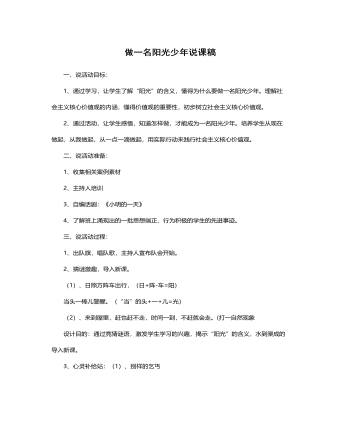
做一名阳光少年说课稿
1、紧密联系学生的生活实际,所选材料、所有活动均本着为主题服务的原则。2、形式多样化。通过心灵补给站、我来当编剧、心动不如行动等丰富多彩的活动,激发学生的热情,充分发挥他们的主体性。3、用生活中的真人真事激励他们,震撼他们的心灵,对学生进行教育,让他们得到感悟。五、说评价方式:要真正发挥主题队会的教育作用,千万不能把主题队会开成“检讨会”、“批评会”。兴趣是最好的老师,在课堂上,学生有了兴趣,才会有学习的动机,所以,在教学过程中,我努力把学生当作一个平等的朋友来对待,对于学生的回答进行评价时,本着“多表扬少批评,多鼓励少指责”的原则,尽量不用指令性、批评性的语言,最大限度的挖掘学生的优点,进行激烈性评价。

追思先烈魂,弘扬爱国情说课稿
环节四深入实践——弘扬爱国情爱国不是一句口号,要将爱国情怀落实到行动中去,队员们在各队队长的组织下,商讨出了落实方案。1、第一小队和第二小队组成了先烈故事演讲团,利用班会十分钟的时间,在三四年级宣讲先烈故事。2、第三小队和第四小队组成了创编小能手,编唱了爱国童谣、爱国拍手歌,告诉大家,爱国无处不在,爱国要从小事做起。3、第五小队和第六小队编写的爱国倡议书,提倡大家让爱国从口号落实到行动。4、全体队员共同宣誓:时刻准备着,为共产主义事业而奋斗,将活动推向了高潮。环节五大队辅导员总结“风雨沧桑,多遭铁蹄践踏,未有沉沦终奋起;荡涤污浊,重聚华夏精魂,披荆斩棘勇向前。”让我们牢记自己是中国人,怀一颗中国心,明确方向,努力奋斗,早日实现自己的梦想。
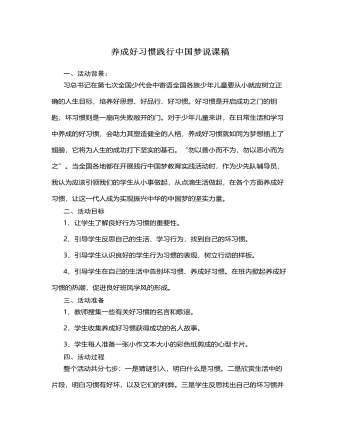
养成好习惯践行中国梦说课稿
第七步:全班学生一起倡读承诺书:(课件出示)我们都是小学生,培养习惯最要紧;上课应当专心听,积极开动小脑筋;作业认真仔细做,按时完成交得勤;有了错误要订正,知识才能学得清;人生要有好习惯,我们牢牢记心上。最后请学生把自己要养成的好习惯写在心意卡上,写好后粘贴在教室后面的园地里,互相督促,使得此次活动教育延续课后,直至影响一生.5、活动效果及反思此次活动开展后,学生们增强了对自身的认识,很多学生下决心改掉自身的坏习惯,并逐步采取了实际行动,从身边的小事做起,而且在学生中间还兴起了互相帮助、互相指正、争相进步的热潮。通过此次活动我也切实的体会到养成教育要开展就要落到实处,从实际出发,让学生亲自去感受,去体会,并且要持之以恒的做下去。同时作为老师更应该有一颗敏感热情的心,随时发现学生身上的闪光点与不足,多指正、多指点、多鼓励、多表扬,做到时时处处皆教育,这样才能赢得孩子,做好教育。
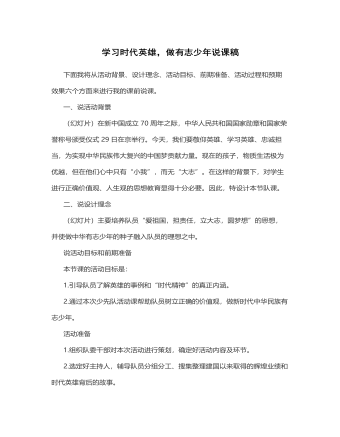
学习时代英雄,做有志少年说课稿
一、说活动背景(幻灯片)在新中国成立70周年之际,中华人民共和国国家勋章和国家荣誉称号颁受仪式29日在京举行。今天,我们要敬仰英雄、学习英雄、忠诚担当,为实现中华民族伟大复兴的中国梦贡献力量。现在的孩子,物质生活极为优越,但在他们心中只有“小我”,而无“大志”。在这样的背景下,对学生进行正确价值观、人生观的思想教育显得十分必要。因此,特设计本节队课。二、说设计理念(幻灯片)主要培养队员“爱祖国,担责任,立大志,圆梦想”的思想,并使做中华有志少年的种子融入队员的理想之中。说活动目标和前期准备本节课的活动目标是:1.引导队员了解英雄的事例和“时代精神”的真正内涵。2.通过本次少先队活动课帮助队员树立正确的价值观,做新时代中华民族有志少年。
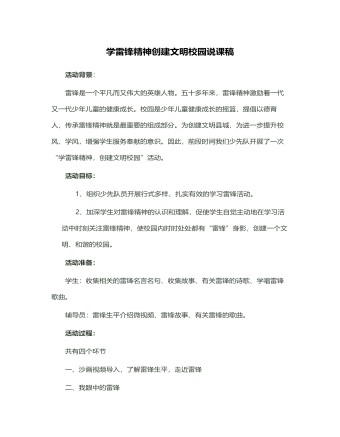
学雷锋精神,创建文明校园说课稿
雷锋精神是什么?这一环节是让学生用简单的词语或句子概括。通过这一活动,让学生概括出雷锋精神的内涵:像无私奉献、乐于助人、为人民服务、勤俭节约、尊老爱幼、勤奋好学、干一行爱一行、言行一致等等都是雷锋精神的体现。我们少年儿童是中国的未来和希望,雷锋精神的发扬和光大,创建文明校园的任务就落在他们的肩上,所以在这里我还设计了为发扬雷锋精神,创建文明校园“我该怎么做”这样的问题,目的就是让他们一起行动起来,学雷锋做好事,并制作了“荣誉”旗,奖励身边的好人好事。活动延伸:这里我设计了一个角色游戏活动——我要义卖献爱心,这个游戏学生们表现得非常积极,他们收集了自己不要的小文具或小玩具,将他们拿到集市上去卖,卖东西获得的钱,捐给王奶奶的孙女,因为王奶奶的孙女生病了,无钱治病。我觉得这个游戏使学生们懂得,一个人只要有爱心,只要愿意去帮助别人,无论什么方式都行,而且在游戏活动中孩子们体会到了帮助别人是一件多么多么快乐的事呀。
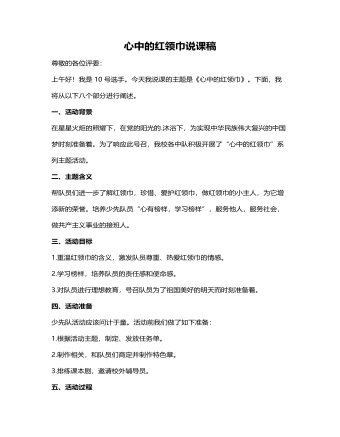
心中的红领巾说课稿
1.学习“最美红领巾”。图文结合,学习“美德少年”刘华婷、刘颖等人的先进事迹。2.记录“平凡红领巾”。展示队员们活动前精心准备的“随手拍”,发现普通队员在日常生活中的闪光点。3.填写“我为红领巾添光彩”心愿卡,对学生进行理想教育。4.齐唱《红领巾之歌》,点燃信念火种。5.辅导员对此次活动进行总结,并颁发特色章。(出示三个特色章图标)六、活动延伸红领巾精神需要代代相传,珍爱红领巾的意识需要时时提醒,本次活动后,我们会开展“小小新四军”、“鲜艳的红领巾”等后续活动,帮助队员们将红领巾精神永远铭记在心。七、引导要点四年级队员具备一定的活动能力和经验,通过课本剧的亲身体验、心愿卡的真情表达等多种方式的运用,引导队员热爱红领巾,以红领巾精神指引自己健康成长。八、活动评价本次活动,队员们受到了良好的教育。但是四年级队员自我约束能力不够强,缺乏持久性,萌生的意识和激情往往只停留在活动时,不能在活动后内化为自觉行为,这些问题有待探究。
今日更新Word
-
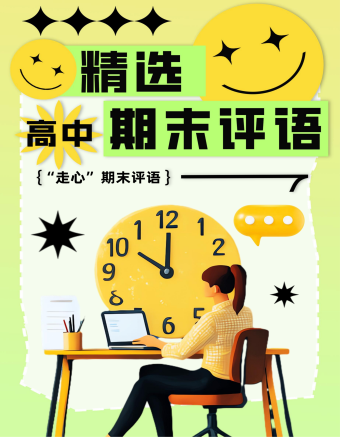
精选高中生期末评语
1、该生学习态度端正 ,能够积极配合老师 ,善于调动课堂气氛。 能够积极完成老师布置的任务。学习劲头足,听课又专注 ,做事更认 真 ,你是同学们学习的榜样。但是,成绩只代表昨天,并不能说明你 明天就一定也很优秀。所以,每个人都应该把成绩当作自己腾飞的起 点。2、 你不爱说话 ,但勤奋好学,诚实可爱;你做事踏实、认真、为 人忠厚 ,是一个品行端正、有上进心、有良好的道德修养的好学生。在学习上,积极、主动,能按时完成老师布置的作业,经过努力 ,各 科成绩都有明显进步,你有较强的思维能力和学习领悟力,学习也有 计划性,但在老师看来,你的潜力还没有完全发挥出来,学习上还要有持久的恒心和顽强的毅力。
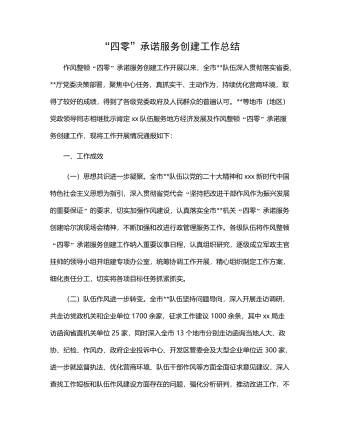
“四零”承诺服务创建工作总结
(二)坚持问题导向,持续改进工作。要继续在提高工作效率和服务质量上下功夫,积极学习借鉴其他部门及xx关于“四零”承诺服务创建工作的先进经验,同时主动查找并着力解决困扰企业和群众办事创业的难点问题。要进一步探索创新,继续优化工作流程,精简审批程序,缩短办事路径,压缩办理时限,深化政务公开,努力为企业当好“保姆”,为群众提供便利,不断适应新时代人民群众对政务服务的新需求。(三)深化内外宣传,树立良好形象。要深入挖掘并及时总结作风整顿“四零”承诺服务创建工作中形成的典型经验做法,进一步强化内部宣传与工作交流,推动全市创建工作质效整体提升。要面向社会和公众庄严承诺并积极践诺,主动接受监督,同时要依托电台、电视台、报纸及微信、微博等各类媒体大力宣传xx队伍作风整顿“四零”承诺服务创建工作成果,不断扩大社会知情面和群众知晓率。
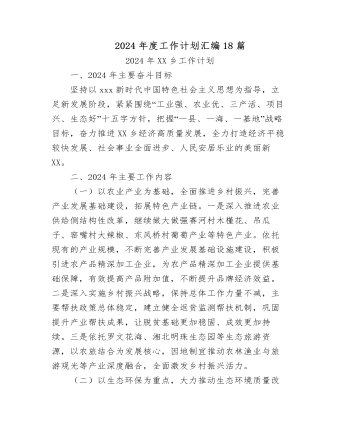
2024年度工作计划汇编(18篇)
1.市政基础设施项目5项,总建设里程2.13km,投资概算2.28亿元。其中,烔炀大道(涉铁)工程施工单位已进场,项目部基本建成,正在办理临时用地、用电及用水等相关工作;中铁佰和佰乐(巢湖)二期10KV外线工程已签订施工合同;黄麓镇健康路、纬四路新建工程均已完成清单初稿编制,亟需黄麓镇完成图审工作和健康路新建工程的前期证件办理;公安学院配套道路项目在黄麓镇完成围墙建设后即可进场施工。2.公益性建设项目6项,总建筑面积15.62万㎡,投资概算10.41亿元。其中,居巢区职业教育中心新建工程、巢湖市世纪新都小学扩建工程已完成施工、监理招标挂网,2月上旬完成全部招标工作;合肥职业技术学院大维修三期已完成招标工作,近期签订施工合同后组织进场施工;半汤疗养院净化和医用气体工程已完成招标工作;半汤疗养院智能化工程因投诉暂时中止;巢湖市中医院(中西医结合医院)新建工程正在按照既定计划推进,预计4月中下旬挂网招标。

驻村工作队2024年第一季度工作总结汇编(4篇)
三是做大做强海产品自主品牌。工作队于xx年指导成立的冬松村海产品合作社,通过与消费帮扶平台合作,在工作队各派出单位、社会团体、个人支持下,已获得逾xx万元销售额。2022年底工作队推动合作社海产品加工点扩建的工作方案已获批,待资金下拨后将正式启动扩建工作。四是积极助企纾困,带动群众增收致富。工作队利用去年建立的xx镇产业发展工作群,收集本地企业在产品销售、技术、人力、资金、运营、用地等方面的需求,并加大xx支持乡村振兴力度,xx助理赴各村委开展多场xx政策支持乡村振兴宣讲活动,本季度有x万元助农贷款获批,xx万贷款正在审批中。在壮大既有产业的同时,完善联农带农机制,一方面鼓励企业雇用本地农户就业,另一方面计划与本地农户签订长期收购合同,让农民种得放心、种得安心,带动当地群众共同致富。

主题教育总结常用提纲大全
第一,主题教育是一次思想作风的深刻洗礼,初心传统进一步得到回归。第二,主题教育是一次沉疴积弊的集中清扫,突出问题进一步得到整治。第三,主题教育是一次强化为民服务的生动实践,赤子之情进一步得到提振。第四,主题教育是一次激发创业担当的有利契机,发展层次进一步得到提升。2.第一,必须提领思想、武装思想。第二,必须聚焦问题、由表及里。第三,必须领导带头、以上率下。第四,必须务实求实、认真较真。3.一是抬高政治站位,坚持大事大抓。二是坚持思想领先,狠抓学习教育。三是突出问题导向,深入整改纠治。四是坚持领导带头,发挥表率作用。4.一是立足“早”字抓筹划。二是着眼“活”字抓学习。三是围绕“统”字抓协调。5.一是形势所需。二是任务所系。三是职责所在。四是制度所定。6.一要提升认识。二要积极作为。三要密切协作。
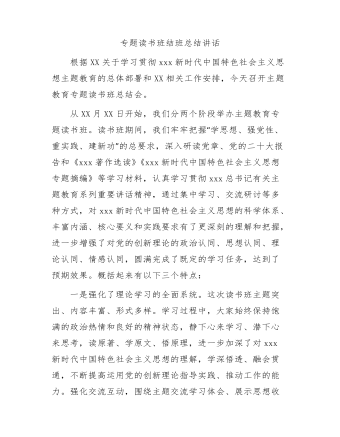
主题教育专题读书班结班总结讲话
第二,要把调查研究贯穿始终,实干担当促进发展。开展好“察实情、出实招”“破难题、促发展”“办实事、解民忧”专项行动,以强化理论学习指导发展实践,以深化调查研究推动解决发展难题。领导班子成员要每人牵头XX个课题开展调查研究,XX月底前召开调研成果交流会,集思广益研究对策措施。各部门、各单位要制定调研计划,通过座谈访谈、问卷调查、统计分析等方式开展调查研究,解决工作实际问题,帮助基层单位和客户解决实际困难。第三,要把检视问题贯穿始终,廉洁奉公树立新风。认真落实公司主题教育整改整治工作方案要求,坚持边学习、边对照、边检视、边整改,对标对表xxx新时代中国特色社会主义思想,深入查摆不足,系统梳理调查研究发现的问题、推动发展遇到的问题、群众反映强烈的问题,结合巡视巡察、审计和内外部监督检查发现的问题,形成问题清单。


















